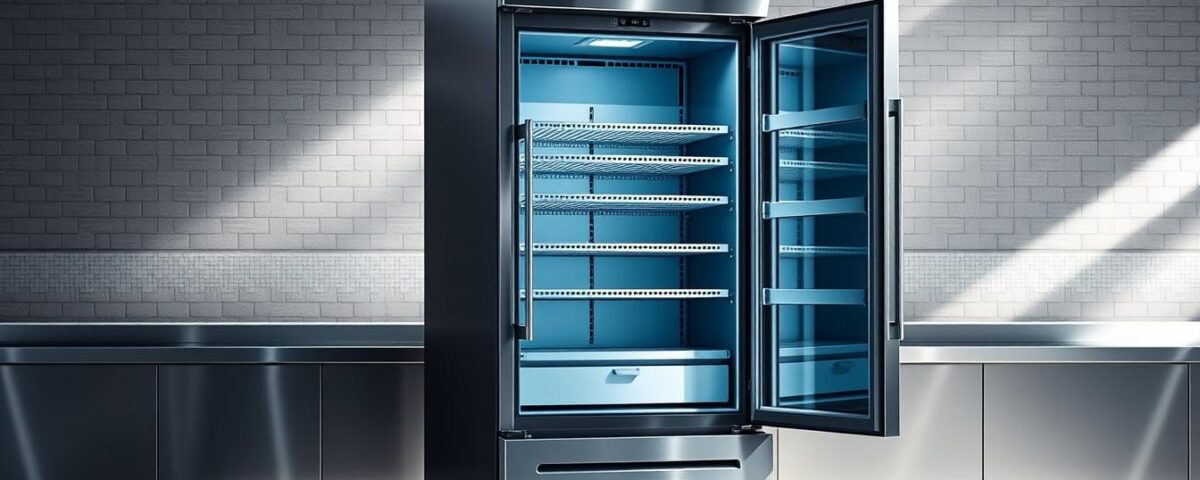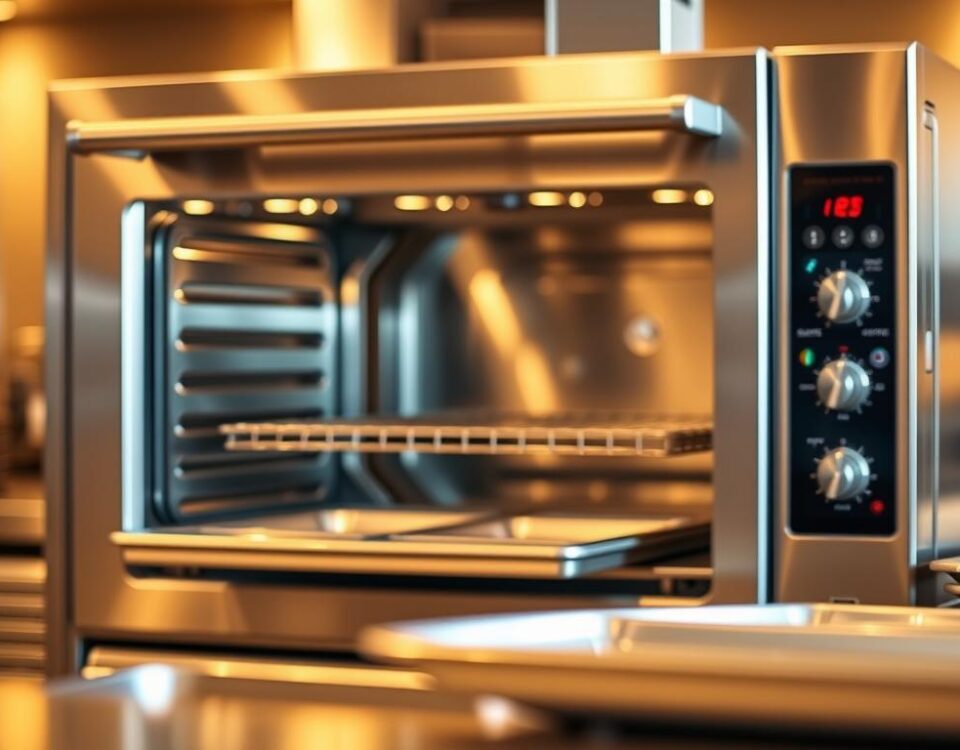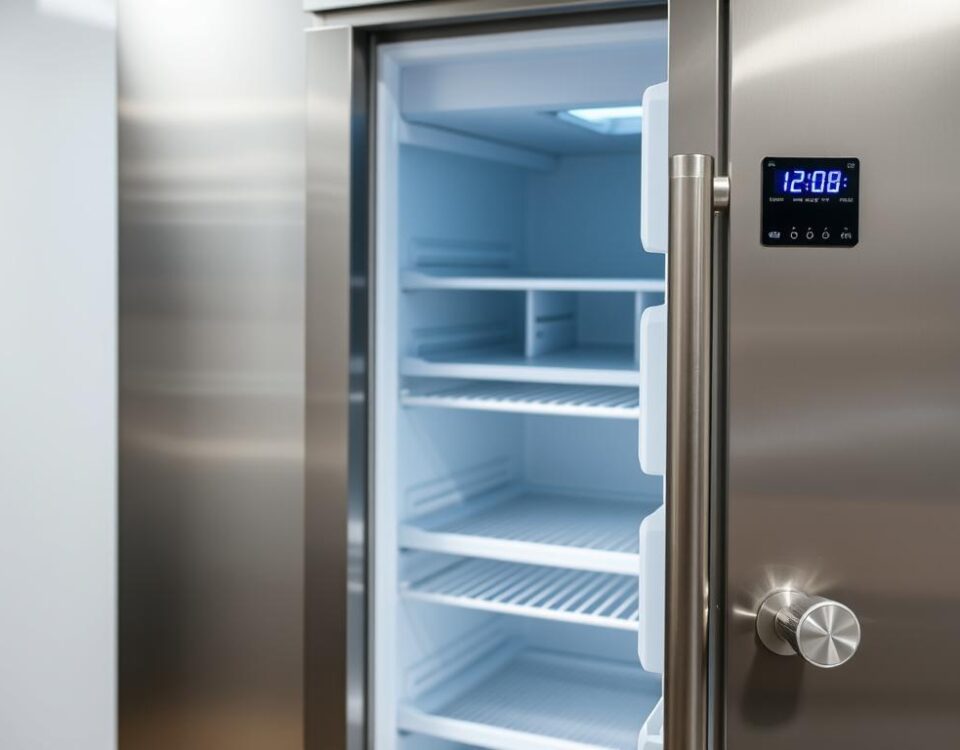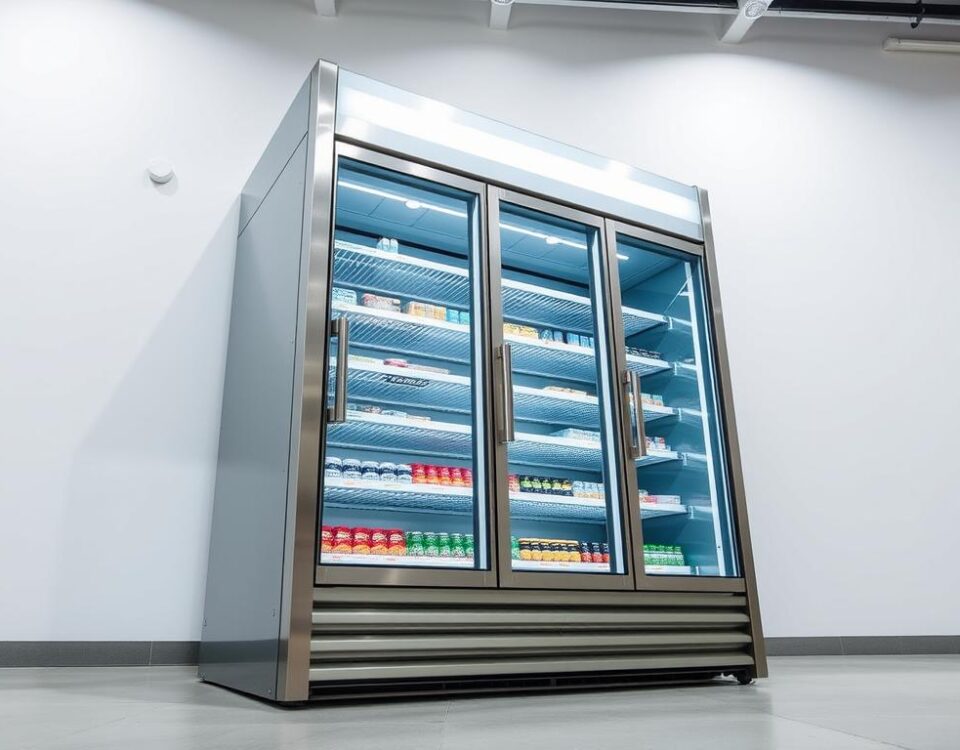
I Compared 4 Commercial Fridges—One Clearly Outclassed the Rest
September 19, 2025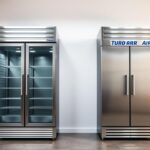
True vs Turbo Air Refrigerator: Which Gives Better ROI?
September 20, 2025As a business owner in the food industry, I’ve seen firsthand how a poorly chosen fridge can lead to spoiled products, increased energy bills, and even equipment failure. For instance, a small café I worked with once opted for a cheaper refrigeration unit to save on upfront costs, only to find themselves replacing it within a year due to inefficiency and frequent breakdowns.
Did you know that according to the U.S. Energy Information Administration, commercial refrigeration accounts for nearly 50% of the total energy consumption in restaurants and food service establishments? This staggering statistic highlights the critical importance of selecting the right equipment for your business.
So, how can you avoid making the same costly errors when choosing a commercial refrigerator for your business? The key lies in understanding the common pitfalls that can cost your business thousands of dollars.
Key Takeaways
- Understand the four most costly mistakes when selecting a commercial fridge.
- Learn how to assess your business needs for refrigeration equipment.
- Discover the importance of energy efficiency in commercial refrigeration.
- Find out how to balance functionality, efficiency, and cost-effectiveness.
- Gain insights into making an informed purchase decision for your business.
Why Commercial Refrigerators Are Critical for Food Businesses
The success of a food business heavily relies on its ability to maintain proper refrigeration, making commercial refrigerators indispensable. In a professional kitchen, these units are among the most frequently used devices, tasked with keeping food at safe temperatures despite constant access.
The Difference Between Commercial and Residential Refrigerators
Commercial refrigerators are fundamentally different from their residential counterparts, designed to withstand the rigorous demands of a food business environment. Unlike domestic refrigerators that may be opened 25-50 times a day, commercial fridges are built to handle hundreds of openings over a few hours, maintaining consistent temperatures through more powerful compressors and robust construction.
The Impact of Refrigeration on Food Quality and Safety
The quality and shelf life of food products are directly impacted by the performance of commercial refrigeration units. Inconsistent temperatures can lead to spoilage, affect texture and flavor, and potentially create food safety hazards. Commercial refrigerators are engineered to maintain precise temperature ranges required for different food categories, ensuring that products remain safe and fresh.
Understanding these differences is crucial for food business owners to appreciate the importance of investing in proper commercial refrigerators, not just for inventory protection but also for maintaining their business reputation and compliance with health regulations.
Common Commercial Refrigerator Buying Mistakes to Avoid
As someone who’s worked in the food service industry, I’ve seen many businesses make costly mistakes when buying refrigerators. Selecting the right commercial refrigerator is a critical decision that affects not just the initial investment but also ongoing operational costs and overall business efficiency.
The Financial Impact of Poor Refrigeration Choices
The financial implications of choosing the wrong refrigerator extend far beyond the purchase price. It influences energy costs, maintenance expenses, and even customer satisfaction. For instance, a restaurant I consulted for chose an undersized refrigerator to save money upfront, only to spend three times that amount on food spoilage and emergency repairs within the first year.
| Cost Component | Initial Cost | Long-term Cost |
|---|---|---|
| Purchase Price | $1,000 | $1,000 |
| Energy Consumption | $0 | $3,000 |
| Maintenance | $0 | $2,000 |
| Food Spoilage | $0 | $1,500 |
| Total | $1,000 | $7,500 |
My Experience with Refrigeration Equipment Selection
My experience has taught me that refrigeration equipment selection should be approached as a strategic business decision. I’ve developed a systematic approach to refrigeration selection based on analyzing business needs, spatial constraints, energy efficiency, and long-term operational costs. By understanding these factors, businesses can avoid common pitfalls and make informed decisions.

Taking the time to understand these common mistakes before making a purchase can save businesses significant headaches and expenses throughout their journey. It’s essential to consider the total cost of ownership, including energy consumption, maintenance requirements, and expected lifespan, rather than just focusing on the initial purchase price.
Mistake #1: Choosing the Wrong Type of Refrigerator
The first major mistake I see is business owners picking a refrigerator that doesn’t match their operational requirements. Commercial refrigerators come in various styles and designs, each tailored for different types of food items.
Understanding Different Commercial Refrigerator Types
Commercial refrigerators are not one-size-fits-all; they come in numerous configurations such as reach-in, walk-in, undercounter, display, and prep tables. Each type is designed for specific functions within a food business.
Matching Refrigerator Type to Your Specific Food Products
For instance, display refrigerators are engineered for customer visibility with glass doors and special lighting, while storage refrigerators prioritize capacity and temperature stability with solid doors. Many food businesses require multiple refrigerator types—a display unit for front-of-house sales and a different storage unit for back-of-house ingredients.
Display Refrigerators vs. Storage Refrigerators
Display refrigerators are ideal for showcasing products like drinks, desserts, or meats, enhancing customer appeal. In contrast, storage refrigerators are better suited for storing ingredients and products that don’t need to be displayed.
Specialized Units for Specific Foods
Specialized units exist for specific food categories, such as floral refrigerators that maintain higher humidity, meat coolers that provide lower temperatures, and wine refrigerators that offer precise temperature zones. Understanding these distinctions is crucial for maintaining product integrity.
Before purchasing, I recommend creating a detailed inventory of what items you’ll be refrigerating and how they’ll be used in your workflow. This helps determine the most appropriate refrigerator type, ensuring operational efficiency and product quality.
Mistake #2: Incorrect Sizing and Space Planning
When selecting a commercial refrigerator, one of the most critical errors is incorrect sizing and space planning. This mistake can lead to operational inefficiencies and premature equipment failure.
How to Properly Measure Your Available Space
To avoid this mistake, it’s essential to measure your available space accurately. I recommend measuring the area three times, considering not just the width and height but also depth, including any protrusions like handles or hinges.
Commercial refrigerators require specific clearance around them for proper ventilation—typically 3-5 inches at the back and sides. Without this clearance, the compressor may overheat, leading to inefficiency and a shortened lifespan.
Ventilation Requirements
Proper ventilation is crucial for maintaining the efficiency and longevity of your commercial fridge. Ensuring adequate clearance around the unit helps prevent overheating and maintains optimal performance.
Door Clearance Considerations
Door clearance is often overlooked but is critically important. I’ve seen kitchens where refrigerator doors couldn’t fully open due to adjacent equipment or walls, severely limiting access to stored items.
Balancing Storage Capacity with Spatial Constraints
Balancing storage capacity with space constraints requires careful consideration of your inventory needs. I generally recommend planning for 20% more capacity than your initial calculations suggest to accommodate future growth.
- Measure your available kitchen space carefully to ensure the fridge fits comfortably.
- Consider the layout of your kitchen workflow when positioning your refrigerator.
- Ensure adequate clearance for doors and maintenance to prevent operational issues.

Mistake #3: Ignoring Energy Efficiency and Operating Costs
The third costly mistake I see business owners make is overlooking energy efficiency and long-term operating costs when selecting a commercial refrigerator. Commercial refrigeration typically accounts for 25-35% of a food business’s total energy consumption, making efficiency a critical factor in overall operational expenses.
Understanding Energy Star Ratings for Commercial Refrigerators
To assess a fridge’s economy in the long run, check its Energy Star rating. Energy Star-certified models are about 10-20% more energy-efficient compared to traditional models. I’ve worked with restaurants that saved over $1,000 annually per unit by choosing Energy Star-rated refrigerators.
Calculating the Long-Term Cost of Inefficient Units
It’s essential to calculate the total cost of ownership by adding the purchase price to the projected lifetime energy costs. Modern energy-saving features like LED lighting and high-efficiency compressors can significantly reduce operating costs.
Insulation Quality and Its Impact on Efficiency
Insulation quality is crucial for maintaining consistent temperatures with less compressor cycling, reducing energy consumption and extending equipment life.
Modern Energy-Saving Features
Features such as variable speed compressors can reduce energy consumption by 15-30% by adjusting cooling power based on actual needs.

By considering energy efficiency and operating costs, businesses can make informed decisions that save money in the long run.
Mistake #4: Overlooking Critical Safety and Performance Features
The fourth costly mistake businesses make is neglecting critical safety and performance features in their commercial refrigerators. This oversight can lead to significant issues, including compromised food safety and increased operational costs.
The Importance of UL Certification
One crucial safety feature is UL certification, which signifies that the refrigerator has passed rigorous safety, sanitation, and performance tests. UL certification is not just a label; it’s a guarantee of credibility to both authorities and customers. Without it, businesses risk compromising food quality and their bottom line.
Auto-Defrost and Temperature Control Systems
Commercial refrigerators need to maintain consistent, safe temperatures, especially during high-usage hours or defrost cycles. Auto-defrost functionality is essential for commercial environments as manual defrosting can be time-consuming and often neglected, leading to reduced efficiency and potential equipment damage.
Door Seals and Gasket Quality
Door seals and gaskets are critical components that deteriorate over time. High-quality, replaceable gaskets extend equipment life and maintain efficiency, while poor-quality seals lead to temperature inconsistency and increased energy use.
Security Features for Valuable Inventory
For businesses storing valuable inventory, such as meat or seafood, security features like lockable doors are essential to safeguard merchandise. Additionally, digital temperature displays and alarm systems provide critical monitoring capabilities, alerting businesses to potential problems before they result in food spoilage or safety issues.
How to Make an Informed Commercial Refrigerator Purchase
Purchasing a commercial refrigerator that’s right for your business demands a thoughtful and multi-step approach. After helping numerous food businesses select the right refrigeration equipment, I’ve developed a systematic method to guide you through this process.
Creating a Requirements Checklist
Start by creating a comprehensive requirements checklist that includes your specific food storage needs, spatial constraints, budget parameters, and energy efficiency goals. This checklist will serve as your guide throughout the selection process.
Researching Reputable Manufacturers
I recommend researching reputable manufacturers with proven track records in the food service industry. Brands like True, Turbo Air, and Beverage-Air have established reputations for quality and reliability. When evaluating manufacturers, consider factors such as warranty coverage, parts availability, and local service options.
Consulting with Industry Experts
Don’t hesitate to consult with industry experts, including equipment dealers who specialize in commercial refrigeration, kitchen designers, and even other business owners in your sector. Visiting showrooms or other businesses to see potential units in person can provide valuable insights into the construction and functionality of different models.
When making your initial selection, keep in mind that the best refrigerator for your business balances initial cost with long-term operational expenses, reliability, and specific functionality for your food products. Consider renting or leasing options for your first refrigerator purchase to provide flexibility as you learn more about your business’s specific refrigeration needs.
Conclusion
By understanding the common pitfalls in commercial refrigerator selection, businesses can make more informed decisions that impact their bottom line and customers‘ satisfaction.
Throughout this guide, I’ve shared expertise on avoiding the four costliest mistakes when selecting a commercial fridge for your food business. Choosing the right refrigerator type, properly sizing for your space and capacity needs, prioritizing energy efficiency, and selecting units with critical safety and performance features will result in better operational outcomes.
Remember, a commercial refrigerator is not just another piece of equipment—it’s a critical investment that directly impacts food quality, safety, and your business. The time you spend researching and selecting the right refrigeration solution will pay dividends throughout your business journey.
I encourage you to keep this guide handy as you navigate the commercial fridge purchasing process, using it as a checklist to ensure you’ve considered all critical factors the right way.
FAQ
What are the key factors to consider when selecting a fridge for my food business?
When choosing a fridge, I consider factors like storage capacity, energy efficiency, and temperature control to ensure my food products remain fresh and safe.
How do I determine the right size of the refrigeration unit for my kitchen?
To determine the correct size, I measure my available space and consider the volume of products I need to store, ensuring a balance between storage capacity and spatial constraints.
What is the significance of Energy Star ratings for refrigeration equipment?
Energy Star ratings indicate the energy efficiency of a unit, helping me make an informed decision that reduces my operating costs and minimizes environmental impact.
Why is UL certification crucial for my refrigeration unit?
UL certification ensures that my refrigeration unit meets rigorous safety standards, protecting my customers, employees, and business from potential hazards.
How often should I perform maintenance on my refrigeration equipment?
Regular maintenance, such as cleaning condenser coils and checking door seals, is essential to maintain optimal performance, efficiency, and prolong the lifespan of my unit.
What are the benefits of auto-defrost and temperature control systems in my fridge?
Auto-defrost and temperature control systems help maintain a consistent temperature, preventing bacterial growth and ensuring my food products remain fresh and safe for consumption.
Can I use a residential fridge for my food business?
I avoid using residential fridges for my food business, as they are not designed to handle the demands of a food service environment and may compromise food safety and quality.
